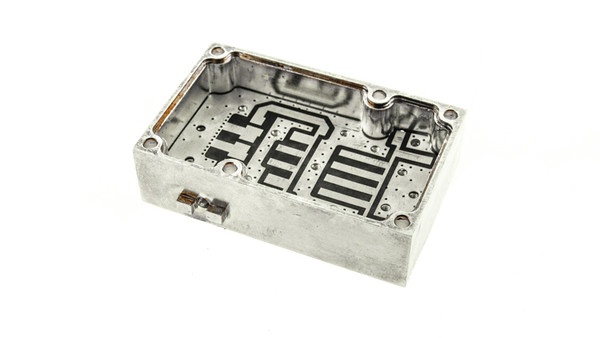Based on the application, electrical, mechanical requirements, and knowing what type of filter topology to use can help exceed the performance of the product. Both of these designs use specific topologies based on frequency and power handling requirements.
Suspended Substrate Stripline Topology
The Suspended Substrate Stripline (SSS) filters are distributed designs that consist of both series and shunt transmission line sections. This style of radio frequency (RF) filter also contains a printed circuit board that is suspended between two parallel ground planes, providing high-Q with most of the electric field operating in air.
Utilizing this type of filter offers a wide range of achievable impedance values make suspended substrate suitable for broadband applications. Typically units exhibit less than 1dB of loss in the passband and 60 dB of rejection within 15% of the 1dB point.

RF Filter Using Suspended Substrate Stripline Topology
A suspended substrate has the ability to withstand severe vibration requirements and extreme operating temperatures of -55°C to +125°C with low frequency drift.
SSS filters are adaptable to broadband configurations and are widely used in systems that are light weight, decreased in size and have high performance with critical parameters.
Lumped Element Topology
Lumped Element (LE) filters have excellent thermal characteristics which are achievable through the use of high Q, thermally stable dielectric materials, and specialized construction techniques.

Example of Lumped Element RF Filters
With LE designs, the mechanical integrity is achieved with lightweight aluminum housings with specialized plating.
This type of RF filter is fabricated with resonators with discrete capacitors and inductors in a lumped form. High-Q porcelain chip capacitors and air-spaced inductive coils are soldered to an RF or Microwave specific copper clad substrate.
Lumped Element filters employ unique techniques to compensate for changes in performance over temperature. With this style of topology, stability is easily achieved over the temperature range of -55°C to +125°C.
SSS Filter Comparative Advantages
In an SSS configuration, the substrate suspended in air is enclosed by a metal channel of rectangular cross section and most of the electromagnetic field is distributed in air. This causes the SSS structure to have a lower loss, higher quality factor, and sharper band edges.
In addition, the SSS structure is more flexible to design in that the circuit patterns are allowed to be deployed on both sides of the substrate. This is because the metal ground printed on the substrate can be removed with the metal housing serving as the ground instead. The metal housing protects the circuit against environmental electromagnetic interference and conversely prevents the circuit from radiating into the exterior space.
The printed circuit patterns on the top and bottom sides of the substrate of BPF A, in which two signal paths exist between the input and output ports. Along the first path, signals entering the input feedline on the bottom side couple to the resonator on the top side first and then couple to the output feedline. Along the second path, signals entering the input feedline directly couple to the output feedline through the end- coupling gap in between.
The cross coupling of signals passing through these two routes can result in noise by the passband edges is minimized.
LE Filter Comparative Advantages
Lumped element filters are constructed with actual inductors and capacitors. The term lumped is derived from the fact that the inductive or capacitive value at each node is lumped into an actual component as opposed to any one of a variety of transmission line elements that synthesize the reactive value.
These filters can be made quite small at lower frequencies where cavity or suspended substrate filters would be quite large due to the long wavelengths associated with low frequencies. Given the frequency of this design, the free space wavelength at 1GHz is just less than 12” so even a quarter wavelength stub would be almost 3”.
The high end frequency limit of these filters is in the range of 6GHz and is limited by availability of practical components. At these frequencies, the sizes of the components become extremely small which limits accuracy and quality.
Wide bandwidth lumped element bandpass filters can easily be implemented by cascading low-pass and high-pass sections in the same housing. Insertion loss and stop band rejection can easily be determined but the downside overall is larger size and the complexity.
Summary
So, what type of filter is best for your application? There are actually too many variables to have a simple answer to this question. Depending on the electrical and mechanical requirements or even the environment in which the filter will operate in are all factors. In our experience, it is best to have all the required data outlined before the design begins to better help gear you towards what topology would work best for your application.
Key Takeaways
- SSS filters deliver high-Q performance by suspending a PCB substrate in air, minimizing loss and improving passband sharpness.
- LE filters are compact and cost-effective at lower frequencies, using discrete capacitors and inductors to achieve stable designs.
- SSS filters withstand harsh conditions, maintaining performance across -55°C to +125°C and under vibration.
- LE filters have frequency limits, typically effective up to about 6 GHz due to component size and tolerance challenges.
- Design selection depends on application needs SSS for broadband and high-performance requirements, LE for size efficiency and lower frequency operation.















